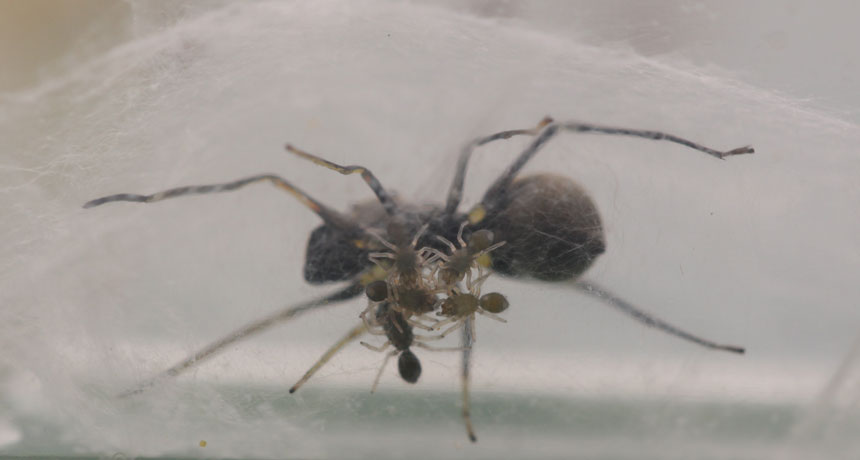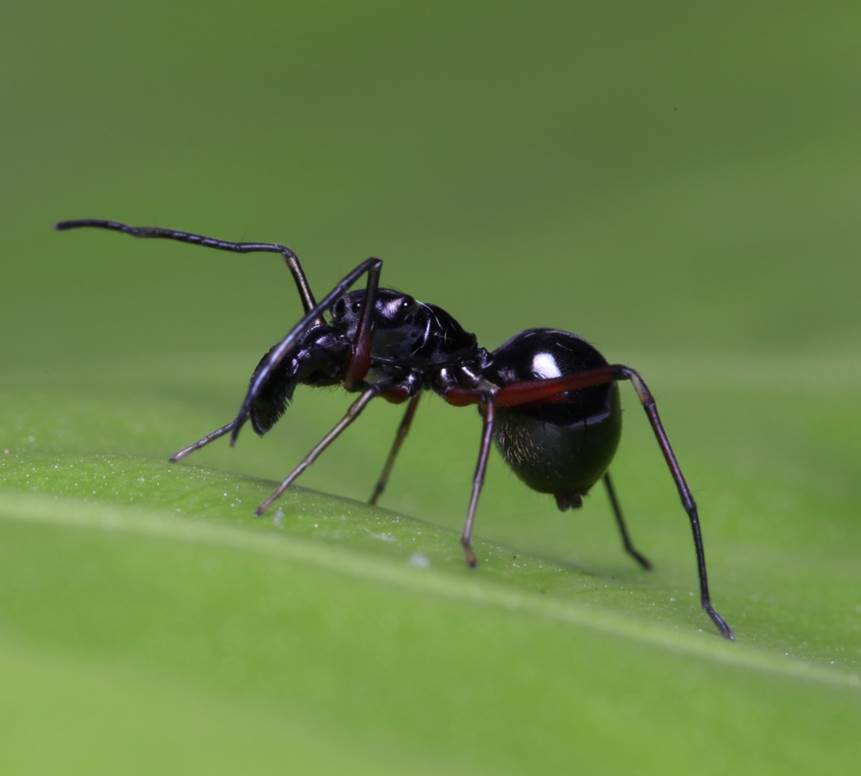|
|
|
| A jumping spider mom nurses her brood for weeks on milk |
 |
Text Size: A A A |
|
Even after spiderlings start hunting for themselves, they come to mom for milk
MOM’S GOT MILK A small jumping spider that looks like an ant will feed her little ones on her own milk, a new study finds. Mom nurses her young for weeks on milk that has four times the protein of a cow’s. Yet this mother’s not a mammal. She’s a jumping spider with eight legs and a taste for fruit flies.We mammals have named ourselves after our mammary glands. Yet other animals, from tsetse flies to pigeons, secrete their own versions of milk for their babies. The newly discovered nursing in Toxeus magnus could be the most mammal-like of all, a research team from China proposes in the Nov. 30 Science.Biologists have recognized T. magnus as a species since 1933, but a small spider’s mothering habit was easy to miss. The spiders hunt beasts such as fruit flies and will retreat to a little nest, perhaps attached to a leaf, to raise a family.Study coauthor CHEN Zhanqi of the Chinese Academy of Sciences in Menglunzhen, who studies spider behavior, noticed several T. magnus sharing a nest in 2012 and wondered if the species had some sort of extended parental care. It was another five years before he spotted the nursing behavior, when a spiderling clamped itself against mom’s underside one exciting July night in 2017.With a T. magnus female under a microscope, a gentle finger push on the underside of the abdomen will squeeze a tiny bead of white liquid out of a crease called an epigastric furrow, the researchers say. For the first week or so after eggs hatch, a spider mom leaves milk droplets around the nest for the crawling dots of her young to drink. Then nursing turns more mammalian, with little ones pressing themselves against their mother’s body. Just how the spiderlings might take up the milk intrigues evolutionary physiologist Wendy Hood of Auburn University in Alabama, who studies lactation. In the platypus and echidna, also known as a spiny anteater, females do not have nipples. Babies lap milk that exudes from the mammary glands to the skin surface “much like water from sweat glands,” she says. In the majority of mammals, however, the baby suckles rather than laps, triggering milk release into its mouth.  A AKER A female Toxeus magnus spider (shown) will feed her young on milk for more than a month.The nourishment packed in the spider milk has basic components familiar in mammal milk: about 2 milligrams of sugar per milliliter of milk, 5 milligrams of fat and 124 milligrams of protein. That’s all spiderlings get for the first 20 days of their lives, the researchers report. In spider nests in the lab, mothers occasionally hunted fruit flies provided by researchers, but never brought any of that prey home to feed to their offspring.After 20 days, the spiderlings started to forage on their own but also kept nursing for nearly another three weeks, the team found. With that combined diet, 76 percent of youngsters in lab nests survived adulthood. But when researchers sealed mom’s epigastric furrow with typists’ correction fluid as soon as spiderlings hatched, they died in about 10 days.Researchers were also curious about whether milk mattered much once the youngsters started hunting. It did. Depriving these older spiderlings by sealing mom’s furrow at day 20 lowered the survival rate to around 50 percent, the researchers say.With such extensive care from mom, T. magnus spiders end up sharing a nest for an unusually long time in the largely solitary, predatory world of spiders, says behavioral arachnologist Linda Rayor of Cornell University. Only about 120 among the nearly 48,000 known spider species are known to tolerate company, including siblings, for more than three weeks. And only about 30 of those live lifelong social lives. So an example of spiders sharing a nest for 40 days, Rayor says, is “a big deal.” URL: https://www.sciencenews.org/article/jumping-spider-mom-nurses-her-brood-weeks-milk |
|

 A
A